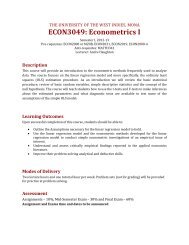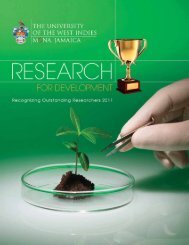Download Pdf - Uwi.edu
Download Pdf - Uwi.edu
Download Pdf - Uwi.edu
- No tags were found...
You also want an ePaper? Increase the reach of your titles
YUMPU automatically turns print PDFs into web optimized ePapers that Google loves.
Industries’ Commitment to EducationData from this investigation revealed thatindustrial organizations contribute resourcesto <strong>edu</strong>cational institutions not just for thesake of philanthropy but also to satisfytheir commitment to <strong>edu</strong>cation, which is anunderpinning philosophy of the industry. Theindustrial/commercial organizations stronglybelieved that they have an important role toplay in preparing students for employmentin industry. They confirmed the belief thatthey should be involved in the curriculumimplementation process, especially in the areaswhere they may have direct benefits.Factors which Influence Industries toContribute to Educational InstitutionsIn addition to philosophy, there are specifickey factors that influence each industrialorganization in contributing to <strong>edu</strong>cationalinstitutions. Factors indicated by industriessurveyed included the leadership of theinstitution, proximity to the industry, highvisibility of school in sports, crime level,government policy, establishment of standardsand the need to prepare a smart competentworkforce.Concern about Existing CurriculumSome industry personnel were particularlyconcerned about the current content andstructure of the curriculum because many ofthe values, attitudes, skills and competenciesrequired by industry were not evident. Severalindicated that the curricula in the <strong>edu</strong>cationalinstitutions are in many instances outdatedand are not engaging the students in modernpractices. This manifests itself in the lack ofappropriate persons available in the communityfrom which the industries could benefit.Work Experience Opportunities InadequateAll <strong>edu</strong>cational institutions involved in thesurvey employed a work experience programmeas part of their curriculum. However, theexperience was not tied to any specific trainingneeds of the student but merely focused on thestudent making a connection with the worldof work. While expressing appreciation forthe opportunities provided by the industrialorganizations, they claimed that in manyinstances, the opportunities provided werenot directly related to the training needs of thestudents.Types of Contributions Made by Industries to EducationalInstitutionsAll industrial organizations surveyed focused primarily on providingmaterial assistance to the <strong>edu</strong>cational organizations. Fifty-five percent(55%) of the industries surveyed provided direct financial assistance forthe <strong>edu</strong>cational institutions with which they interact. Fifty percent (50%)provided opportunities for work experience of students. Approximately60% of the industries provided scholarships for either excellent orneedy students. A similar percentage provided books, materials, toolsand equipment for the <strong>edu</strong>cational institution. Not surprisingly, a largepercentage (68%) provided job opportunities for the students from theinstitutions with which they interact. Approximately eighteen percent(18.20%) provided assistance of a general nature which includedcurriculum development.Management of Interaction between Industries and EducationalInstitutionsBoth <strong>edu</strong>cational and industrial respondents indicated that therewas need for improvement in the management of their interaction tofacilitate industries’ involvement in the curriculum development andimplementation. All respondents in the study indicated that the principalor the chief executive officer of the <strong>edu</strong>cational institution should begiven the responsibility to administer and coordinate the interaction, butthat personnel from both organizations should participate in managingthat interaction.Future PlansAll <strong>edu</strong>cational institutions and industries surveyed supported theconcept of industries interacting with <strong>edu</strong>cational institutions. While notmaking specific commitments, more than seventy-five percent (75.50%)of persons from industrial organizations interviewed pledged to givecontinuous support to these programs, however, most were concernedabout its sustainability because this interaction requires continuoussourcing of funds to maintain the programmes. Two industries were lessconcerned about sustainability since they had established Foundationsthrough which these engagements are managed.Economic BenefitsThe economic benefit of the formal interaction between the industrialorganization and <strong>edu</strong>cational institutions is no doubt important andcan be a significant engagement. One major benefit is the level ofconfidence that both industry and the <strong>edu</strong>cational institution will havein their programmes. Another benefit is the r<strong>edu</strong>ction of frustrationof determining curriculum content, especially in the determination ofcontent which is truly relevant for both instructional and occupationalsettings. Industries expressed that a major benefit is the r<strong>edu</strong>ction ofthe training that they have to provide for the graduate when employed.The student will graduate with a good understanding of the demandsof industry. Lack of interaction may result in pressures from business,industries, professional organizations, unions and other entities that relyon the curriculum for their development.Halden Morris is a senior lecturer in the Institute of Education.halden.morris@uwimona.<strong>edu</strong>.jm24 25

















